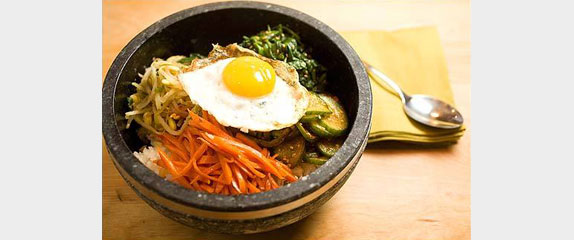Bap till you drop
Bap till you drop
By Debra Samuels, Globe Correspondent November 5, 2008
In Korea, some foods trickled down from the Imperial palace and others have humbler origins. Bibimbap seems to be somewhere in the middle – a dish thought to have been introduced to Korean monarchy by the court of China, but also served to farmers in their fields.
This layered specialty consists of rice, meat or seafood, and seasoned vegetables, topped with an egg. It’s as much a part of the Korean table as risotto is to Italy or paella to Spain. Unlike those dishes, bibimbap isn’t made with uncooked rice, but rather with the cooked grains, which makes it more akin to Chinese fried rice. In this country, look on the menu of any Korean restaurant, and you’ll find at least one version of bibimbap. In Korea, there are restaurants that specialize in the dish.
Ingredients vary according to region and season. Bibimbap can be served hot or at room temperature. A stone pot version, called dolsot bibimbap, is made in a well-seasoned stone bowl ($25 at Korean markets), which produces a crisp, crunchy bottom. When it’s done, the rice continues to cook and crackle from the heat of the stone. Whatever the cooking pot, the dish always contains vegetables, which might include bean sprouts, carrots, cucumber, and spinach. After cooking, the ingredients are combined with a flourish and finished with sesame oil and spicy red pepper sauce. Hence the name bibim (mixed) bap (rice).
Every Korean mother prepares the dish. “Making bibimbap was a way for my mom to clean out the fridge of all the leftover side dishes,” explains Kiki Oh, owner of the Bibimbab Cafe in London, made famous by Margaret Drabble’s novel “The Red Queen,” which starts in 18th-century Korea and ends with Drabble herself enjoying a bowl of bibimbap in Oh’s cafe.
At home, bibimbap is a project. Unlike Chinese fried rice – where all the vegetables are stir-fried together and mixed into the rice – bibimbap’s vegetables are cooked separately before they’re added to the grains, which accentuates individual characteristics such as sweet, crunchy, salty.
Some cooks think mixing the dish at the end of cooking is important to how it tastes. At Seoul Food restaurant in Cambridge, the servers want you to enjoy the dish properly, so you may find your spoon pulled out of your hand and your dish folded together with the runny egg by one of the staff.
Boston University graduate student Kelly O’Leary is besotted with Korean food in general and bibimbap in particular. O’Leary, chef at the Bayridge residence in Back Bay, is in the Master of Liberal Arts program in gastronomy. “I just love the beauty of the dish,” says O’Leary, who is writing a paper on bibimbap. “I eat a dish and then deconstruct it.” Recently she attended a Korean food festival in New York, where a 500-pound bowl of bibimbap was served to hundreds of passersby in Manhattan’s Koreatown.
To make the dish, use an old-fashioned American cast-iron skillet, which gives the rice its nice texture and holds in the heat as you serve it. Consider the presentation more relaxed than royal.
Debra Samuels is coauthor with Taekyung Chung of “The Korean Table.”
*For photos on how to make bibimbap go to: http://www.boston.com/lifestyle/food/gallery/05bibimbap/
RECIPE
Bibimbap Recipe
Serves 4
Make bibimbap in a deep cast-iron skillet, which produces a crispy crust on the bottom, or a nonstick skillet. The dish consists of rice and toppings, including an egg. Here are instructions for bean sprouts, carrot salad, cucumber salad, spinach, beef, and a tangy red pepper dressing. Use about 1 cup of each. This recipe has one egg, but you can also make one for each person. Add them to the bowls after serving.
SPROUTS
1/2 cup water
1 teaspoon salt
12 ounces soybean sprouts
2 scallions, chopped
1 tablespoon toasted sesame seeds
1 tablespoon dark sesame oil
1. In a medium saucepan, combine the water, salt, and sprouts. Bring to a boil, reduce the heat to low, cover, and steam for 5 minutes.
2. Strain the sprouts and transfer to a bowl. Add the scallion, sesame seeds, and sesame oil.
CARROTS
1 tablespoon dark sesame oil
4 carrots, cut into matchsticks
1/2 teaspoon sea salt
1. In a skillet, heat the oil over medium heat. Add the carrots and salt. Stir-fry for 2 minutes.
2. Remove them from the pan.
CUCUMBERS
4 Armenian or pickling cucumbers or 1/2 English cucumber, thinly sliced
1 teaspoon salt
2 tablespoons red pepper dressing (see below)
1 tablespoon toasted sesame seeds
1. In a large bowl, toss the cucumbers and salt; set aside for 5 minutes. Gently squeeze the liquid from the cucumbers. Transfer to a bowl.
2. Add the dressing. Sprinkle with sesame seeds.
RED PEPPER DRESSING
2 tablespoons Korean red pepper paste (from a Korean grocery)
1 tablespoon rice or cider vinegar
1 teaspoon honey
1 tablespoon apple juice or water
2 teaspoons sesame oil
1. In a medium bowl, whisk together the pepper paste, vinegar, honey, juice or water, and sesame oil.
2. Set the dressing aside.
SPINACH
1 pound fresh spinach, rinsed and stemmed
2 tablespoons toasted sesame seeds
2 tablespoons dark sesame oil
1 teaspoon salt
1. In a pot of boiling water, cook the spinach for 1 minute. Drain and rinse with cold water. Squeeze out the water by the handfuls. Chop coarsely.
3. Transfer the spinach to a bowl. Add sesame seeds, oil, and salt.
BEEF
2 ounces beef rib eye, cut into strips (or use ground beef)
2 teaspoons soy sauce
1/2 teaspoon sesame oil
1 teaspoon brown sugar
1. In a bowl, combine the beef, soy sauce, sesame oil, and sugar; marinate for 15 minutes.
2. Heat a small skillet. Stir-fry the meat for 2 minutes; set aside.
ASSEMBLY
2 tablespoons sesame oil, plus more for sprinkling
3 cups cooked white rice
1 egg, fried sunny-side up
3 tablespoons red pepper dressing (see above)
1. Set a 10-inch skillet over medium heat. When it is hot, add 2 tablespoons of sesame oil. Heat for 1 minute.
2. Add the rice and spread it around the bottom of the pot to form an even layer. Cook for several minutes or until the rice begins to brown on the bottom and you hear the grains sizzle.
3. Carefully arrange each of the seasoned salads on top of the rice, grouping them like the spokes of a wheel. Set the beef in the center. Continue heating for 2 minutes. Set the egg in the center.
4. To serve: Add the dressing and fold the rice, vegetables, egg, and meat together, scraping the bottom of the pot to distribute the crust. Serve in individual bowls, sprinkled sparingly with sesame oil and extra dressing. Adapted from “The Korean Table”












 Debra Samuels, bestselling author, food writer and cooking instructor,
Debra Samuels, bestselling author, food writer and cooking instructor,